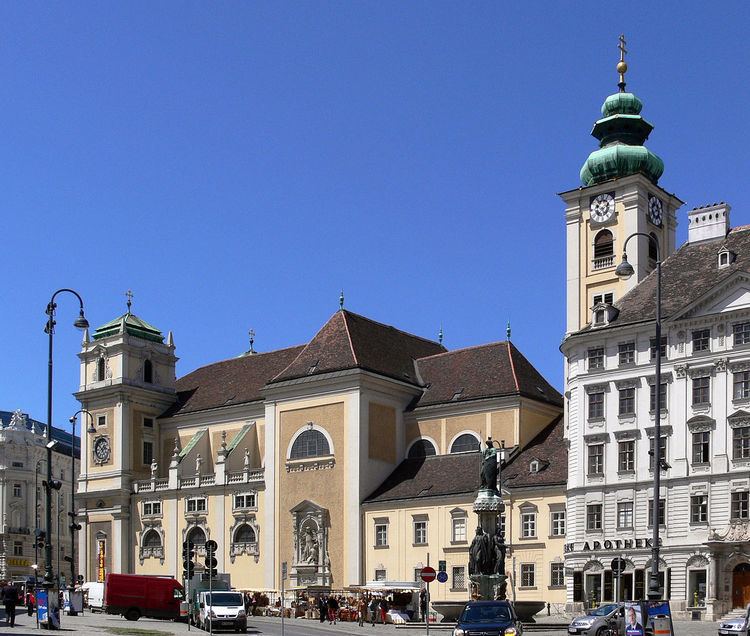Leadership P. Nikolaus Poch o.s.b Direction of façade W Architectural style Baroque architecture Architectural type Minor basilica | Website www.schottenpfarre.at Length 55 m Phone +43 1 53498200 | |
 | ||
Architects Carlo Antonio Carlone, Marco Spazzio Similar Schottenstift, Freyung - Vienna, Minoritenkirche, St Michael's Church - V, Maltese Church - Vienna | ||
The schottenkirche vienna
The Schottenkirche (English: Scottish Church) is a parish church in Vienna attached to the Schottenstift, founded by Hiberno-Scottish Benedictine monks in the 12th century. In 1418, the Duke Albert V of Austria transferred it to the German-speaking Benedictine monks from the Melk Abbey during the Melker Reform initiated after the Council of Constance. The church has been elevated to the rank of Basilica Minor in 1958.
Contents
- The schottenkirche vienna
- Si bhaeg si mhor at the schottenkirche vienna
- History
- Exterior
- Interior
- Trivia
- References
The Schottenkirche is located in the Freyung in the first district of Vienna's Innere Stadt.
Si bhaeg si mhor at the schottenkirche vienna
History
Scottish and Irish missionaries (Iro-Scottish, Hiberno-Scottish) were instrumental in the spread of Christianity in Continental Europe during the Middle Ages. Of special importance in Austria is Saint Koloman of Stockerau (of Melk) killed near Vienna in 1012. This Iro-Scottish monk of royal lineage killed at Stockerau while on pilgrimage to Jerusalem has been patron saint of Austria until 1663.
During the 11th and the 12th century, Scottish Monasteries intended for Scottish and Irish monks exclusively sprang up. The famous Scottish Monastery of St. Jacob at Ratisbon was built around 1090 by Burgrave Otto of Ratisbon in Ratisbon became the mother-house of a series of other Scots Monasteries, among which the Our Blessed Lady at Vienna built in 1158.
Exterior
The first church was a three-aisled Romanesque pillar church with a single apse, destroyed by a fire in 1276.
An earthquake circa 1443 greatly damaged the existing church on the site. Restorations were completed by 1449 but poorly done, due to lack of money, and on 21 May 1634, the roof collapsed in full view of Ferdinand II, Holy Roman Emperor.
The collapse of the tower, struck by a lightning bolt in 1638, was seized as an opportunity to completely rebuild the church in Baroque style. From 1638–1641, the reconstruction was undertaken by the architects by Carlo Antonio Carlone and Marco Spazzio. From 1643–1648, Andrea Allio the Old, Andrea Allio the Young and Silvestro Carlone reworked the nave and the west side. In the process, the length of the church was somewhat reduced, with the result that the tower no longer stands directly beside the basilica.
After the Turkish siege, the church was restored again. As the baroque west tower was barely higher than the facade itself, its extension has often been discussed, but these plans have never come to fruition. The choir tower was dedicated only in the year 1893.
Interior
Inside, the church is now in high-baroque style with several chapels. Joachim von Sandrart provided the church with a new altar-piece, which today is kept in the prelates' hall.
Between 1883–1889, the high altar was built after sketches of Heinrich Ferstel, with Innsbruck glass mosaics by Michael Riese. Julius Schmid (Austrian, 1854–1935) was artist for the fine ceiling paintings.
